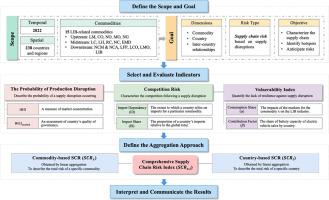锂离子电池全球供应链多维度风险评估
IF 6.4
Q1 ENVIRONMENTAL SCIENCES
引用次数: 0
摘要
在电动汽车和可再生能源发展的推动下,近年来对电池材料的需求激增,同时对供应链稳定性的担忧也在加剧。以前的研究从多个角度评估了这些风险,但整体情况仍不清楚。本研究评估了全球锂离子电池(LIB)行业的供应链风险,涵盖238个国家和地区以及15种与锂离子电池相关的关键商品。我们整合了三个维度来开发风险评估模型:生产中断的可能性、竞争风险和脆弱性,提供了供给侧和需求侧风险的整体视图。结果表明,氢氧化锂和LIB的供应链风险最高,主要是由于生产集中,需求分散。日本、韩国和美国等国面临供应链风险上升。低钴技术的早期采用者通过减少资源竞争,在一定程度上减轻了风险。基于这些发现,该研究强调了供应链多样化和加速技术转型的重要性。进一步强调了在高地理和技术粒度上评估和提高复原力的努力。本文章由计算机程序翻译,如有差异,请以英文原文为准。

Evaluating multi-dimensional risks embodied in the global supply chain of lithium-ion batteries
Driven by the development of e-mobility and renewable power, recent years saw a surging demand for battery materials along with concerns about the supply chain stability. Previous studies have assessed such risks from multiple perspectives while the whole picture is still unclear. This study evaluated global supply chain risks in the lithium-ion battery (LIB) industry, covering 238 countries and regions and 15 key LIB-related commodities. We integrated three dimensions to develop a risk assessment model: the probability of production disruptions, competition risk, and vulnerability, offering a holistic view of both supply- and demand-side risks. The results reveal that lithium hydroxide and LIB exhibit the highest supply chain risks, primarily due to concentrated production and widely dispersed demand. Countries such as Japan, South Korea, and the United States face elevated supply chain risks. Early adopters of low-cobalt technologies have somewhat mitigated risks by reducing their exposure to resource competition. Based on these findings, the study underscores the importance of diversifying supply chains and accelerating technological transitions. The efforts to assess and improve resilience at high geographic and technical granularity are further highlighted.
求助全文
通过发布文献求助,成功后即可免费获取论文全文。
去求助
来源期刊

Resources, conservation & recycling advances
Environmental Science (General)
CiteScore
11.70
自引率
0.00%
发文量
0
审稿时长
76 days
 求助内容:
求助内容: 应助结果提醒方式:
应助结果提醒方式:


